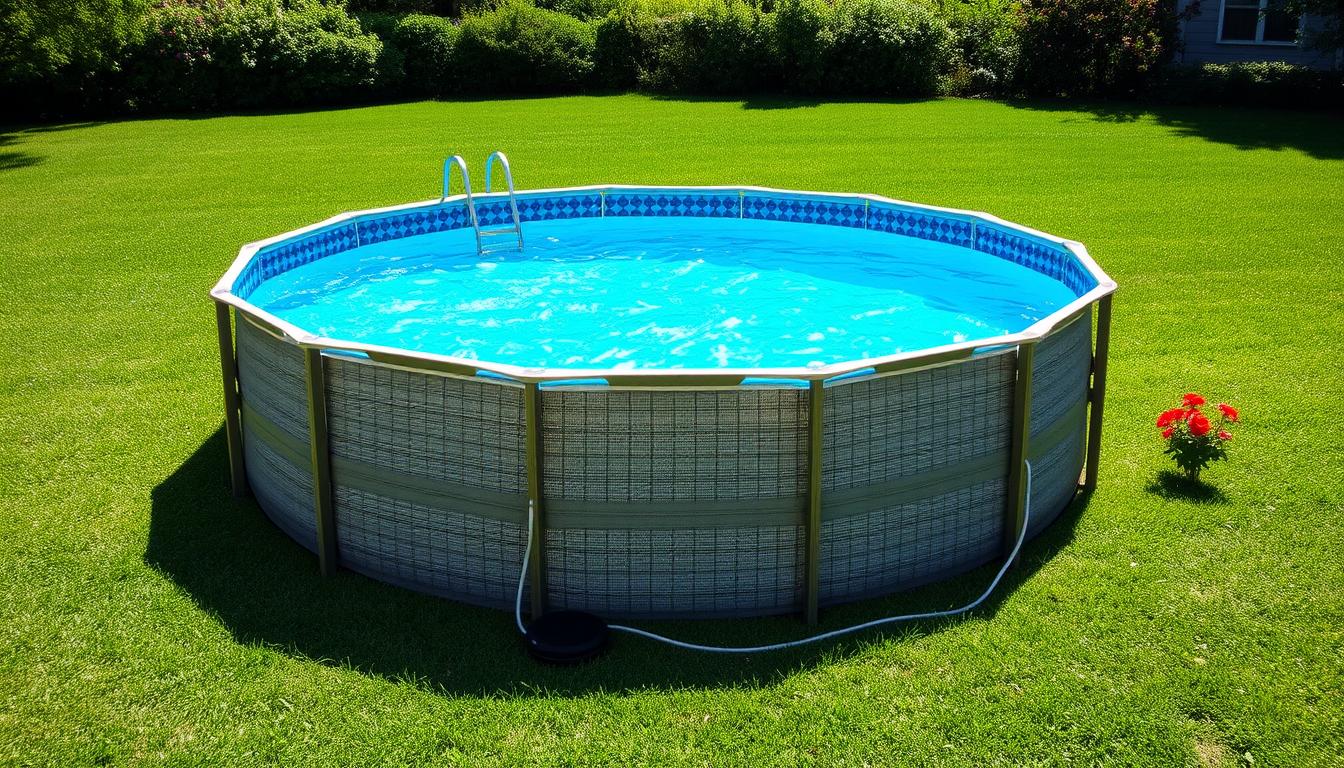
Knowing your 24-foot round pool’s capacity is vital. It affects chemical balance, equipment selection, and costs. This knowledge ensures proper maintenance and efficient operation.
Pool volume impacts chemical needs, pump sizing, and filtration. It also helps with water conservation and energy usage decisions. These factors contribute to cost savings and environmental responsibility.
Understanding pool capacity is key for a safe, enjoyable swimming environment. It helps maintain clean, balanced water and select the right equipment. This knowledge also aids in making informed decisions about resource use.
Key Takeaways:
- A 24 foot round pool with a 52″ wall height holds approximately 14,652 gallons
- Pool volume affects chemical balance, equipment selection, and water and energy costs
- Understanding pool capacity is crucial for maintaining a safe and enjoyable swimming environment
- Calculating pool volume involves considering factors such as pool shape, depth, and wall height
- Our quick calculator simplifies the process of determining the number of gallons in your 24 foot round pool
Understanding Pool Volume
Knowing your pool’s volume is vital for proper maintenance. It affects water quality, equipment efficiency, and costs. Let’s explore why pool volume matters and what influences it.
Importance of Knowing Your Pool’s Gallon Capacity
Pool volume is crucial for several reasons. It determines the right amount of chemicals for water balance. It helps size equipment correctly for optimal performance.
Knowing your pool’s volume also aids in estimating water usage and costs. This information is valuable for budgeting and managing your water bill.
- Proper chemical treatment: The amount of chemicals needed to maintain water balance and clarity depends on the volume of water in your pool. Accurate pool size conversions ensure that you add the right amount of chemicals, avoiding over- or under-treatment.
- Equipment sizing: Your pool’s volume determines the appropriate size and capacity of equipment such as pumps, filters, and heaters. Properly sized equipment ensures optimal performance and energy efficiency.
- Water usage and costs: Understanding your pool’s volume helps you estimate the amount of water needed to fill the pool and the associated costs. This information is valuable for budgeting and managing your water bill.
Factors Affecting Pool Volume
Several factors influence your pool’s volume. These include shape, diameter, and wall height. Each plays a role in determining water capacity.
- Shape: The shape of your pool, whether it’s round, oval, or rectangular, impacts its volume. Round and oval pools typically have a smaller volume compared to rectangular pools of similar dimensions.
- Diameter: The diameter of your pool directly affects its volume. Larger diameters result in greater water capacity. Common above-ground pool diameters range from 15′ to 33′.
- Wall height: The height of your pool’s walls also contributes to its volume. Most above-ground pools have wall heights of 48″ to 54″. Taller walls increase the pool’s depth and, consequently, its volume.
Let’s look at how these factors affect pool volume:
| Pool Size | Water Volume (Gallons) |
|---|---|
| 15′ x 52″ | 5,724 |
| 18′ x 54″ | 8,565 |
| 24′ x 52″ | 14,652 |
| 30′ x 54″ | 23,793 |
Small changes in pool size can greatly impact volume. Consider these factors when planning your backyard pool. Choose a size that fits your needs and budget.
Understanding your pool’s volume is the foundation for effective pool maintenance and enjoyment. By considering factors such as shape, diameter, and wall height, you can make informed decisions about your pool’s size and the resources required to maintain it.
Calculating Gallons in a 24 Foot Round Pool
Knowing the water volume is crucial for pool installation and maintenance. It helps plan resources and costs for filling your pool. Let’s explore how to calculate gallons for a 24-foot round pool.
Formula for Determining Pool Volume
The formula for a circular pool’s volume is:
Volume = π x radius² x depth x 7.48
Here, π is 3.14, radius is half the diameter, and 7.48 converts cubic feet to gallons.
Step-by-Step Guide to Calculating Gallons in a 24 Foot Round Pool
Let’s break down the process:
- Determine the radius of the pool by dividing the diameter (24 feet) by 2, which gives us a radius of 12 feet.
- Calculate the average depth of the pool by measuring the depth at the shallowest and deepest points, then averaging those values. For this example, let’s assume an average depth of 4.33 feet (52 inches).
- Plug the values into the formula: Volume = 3.14 x 12² x 4.33 x 7.48
- Simplify the equation by multiplying the values: Volume = 3.14 x 144 x 4.33 x 7.48
- Calculate the final result, which in this case is approximately 14,652 gallons.
Real-World Example: A 24′ Round Pool with 52″ Wall Height Holds 14,652 Gallons
A 24-foot round above-ground pool with a 52-inch wall height holds about 14,652 gallons. This info helps estimate time and resources needed for filling your pool.
| Pool Diameter (feet) | Wall Height (inches) | Gallons |
|---|---|---|
| 24 | 48 | 13,593 |
| 24 | 52 | 14,652 |
Knowing your pool’s water volume helps with installation planning. It ensures you have the right resources for your pool water needs.
Conclusion
Calculating your 24-foot round pool’s capacity is vital for proper maintenance. It helps you make smart choices about chemicals, heating, and filtration. Our guide makes it easy to figure out your pool’s gallon capacity.
When installing an above-ground pool, check installation guides and specifications carefully. Consider your backyard space and desired pool size. This ensures you pick the perfect shape and dimensions for your outdoor oasis.
Armed with this knowledge, you can confidently plan your above-ground pool. You’ll be able to maintain a safe, healthy swimming environment. Start creating your dream backyard pool today!







